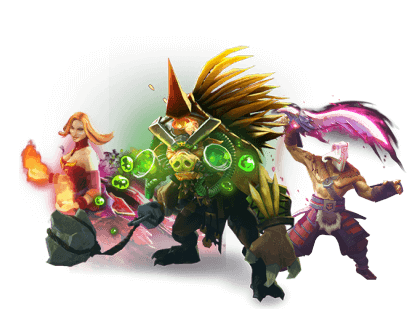Dota 2 Positions and Roles Advanced Guide
Dota 2 is in many ways similar to a team sport, where it’s not just awesome individual abilities, but also great teamwork that achieves victory. What’s important here is mutual understanding, accurate communication, and timely, collaborative decision-making. Teams with have strong synergy usually do well and often win in teamfights.
- First Position – Carry
- Second Position – Midlaner
- Third Position – Offlaner
- Fourth Position – Roamer
- Fifth Position – Hard Support
To begin with, let’s see what types of roles and Dota 2 positions are in the game so far and which heroes are most suitable for each of these roles.
The First Position – Carry
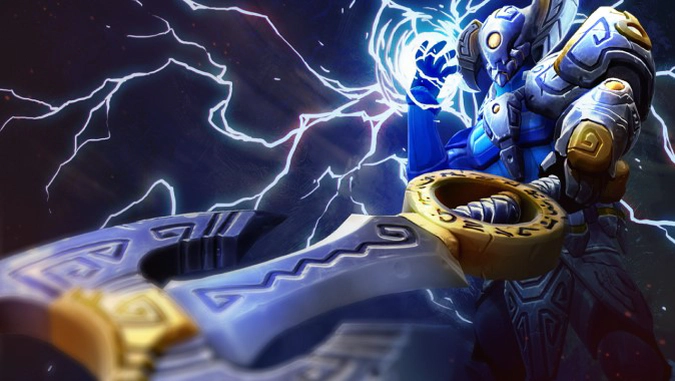
What does “Carry” mean in Dota 2? It is the main combat unit of the team, and deals damage in the teamfight. A Carry’s task is simple but important: to kill as many enemy units as possible. This includes creeps from the start, and heroes when the necessary artifacts appear.
Also, the role of Carry is often taken by heroes capable of causing a lot of damage to enemy structures, the so-called Pushers.
Carry on the Laning Stage
The Carry hero is basically positioned on the easy lane; this is the bottom lane when playing on the light side and conversely, the top one if playing on the dark side. From this lane, the hero has quick access to a large number of camps in the allied forest, as well as the potential to quickly retreat to the allied tower and avoid getting ganked.

Throughout most of the game a Carry hero needs to farm a lot and collect the necessary artifacts as soon as possible. To do this, he requires Supporters, who help him on the lane and in the allied forest. The enemy hero standing with the Carry on the lane is called an Offlaner or Offlane hero.
Sometimes an Offlaner is followed by one or two Support heroes which prevent the Offlaner from farming. During the Laning phase a Carry must kill as many creeps as possible and do his best to survive in any case, even if his allies are dying and badly need his assistance.
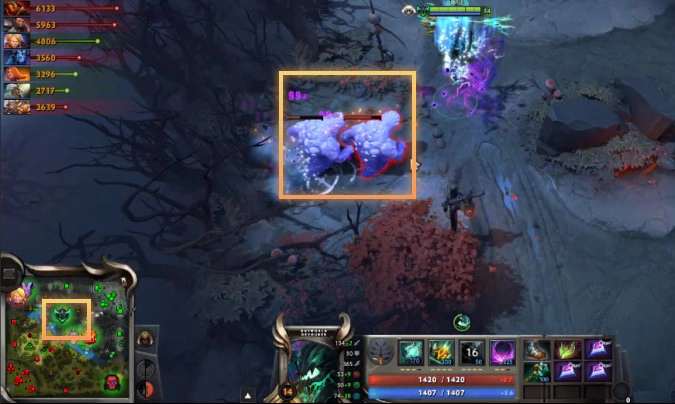 A Carry can pick a fight with enemy heroes only if he is sure to win and manage to survive, since his priority is farming.
A Carry can pick a fight with enemy heroes only if he is sure to win and manage to survive, since his priority is farming.
Carry on the Fighting
As mentioned above, the Carry is the core unit that inflicts most damage, especially after 20 minutes of play, when he acquires useful artifacts.
Of course, every game is very situational, and general rules may not work. Either way, the very first task of a Carry is to quickly kill the enemy’s Supports with a lower armor value. You may as well ignore weaker Support heroes and try to attack the enemy Carry instead, but it is too risky as Supports usually help the allied Carry with buffs and can disable your abilities. So, make weaker heroes your first targets, and then proceed with stronger ones.
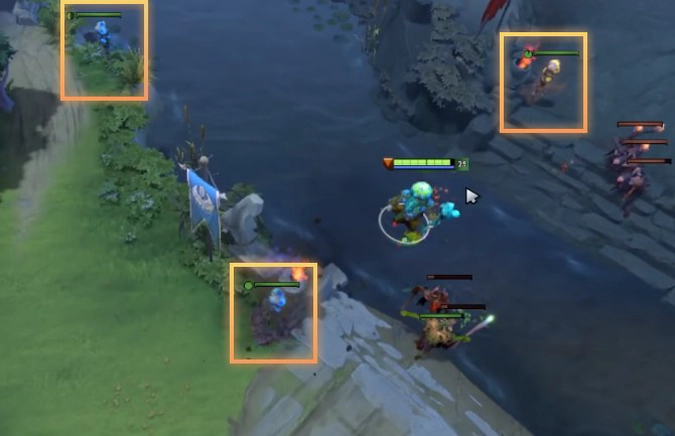
To avoid becoming a primary target for his enemies, a Carry should not initiate teamfights. During the Laning phase and further along the game, a Carry must prioritize his own survival, which is by far the most important thing for the entire team.
Therefore, it is better to save your life and continue the game than die with all your allies and lose it.
So if the enemy heroes are prevailing, you’d be better off retreating from a fight than engaging in it.
Carry Heroes Examples
Agility heroes are largely the most suitable for this role, as they inflict a large amount of damage not due to their abilities, but with continuous physical attacks.
- Strength Carries: Lifestealer, Alchemist, Wraith King, Sven
- Agility Carries: Anti-Mage, Faceless Void, Drow Ranger, Luna, Phantom Assassin, Medusa
- Intelligence Carries: Outworld Devourer, Nature’s Prophet
Second Position – Midlaner

The name of the position, Midlaner, comes from the central lane, which in the Dota 2 community is called Middle or Mid. The heroes going to the central lane are mostly self-sufficient and need no help to farm. As a rule, two Midlaners from opposing factions stand against each other on this lane.
Heroes on the middle lane must have active attack abilities or at least be able to inflict lots of damage at the very beginning of the game, even without having a large number of artifacts.
Midlaner on the Laning Phase
Heroes on the central lane gain experience and go up a level faster than the heroes on other lanes, since Midlaners are the only ones who stand in the mid lane. After gaining level 6, this can be used as an advantage to gank enemy heroes on other lanes, as they are usually only level 3–4 at that time.
Such attacks allow you to break up the farming momentum of enemy Carry or Offlaner heroes. Besides, your hero can gain a lot of gold and experience and let your allies farm safely.
The number of creeps killed is the key farming indicator for Midlaners as each kill provides gold and experience. To beat your opponent, try to kill more creeps and move up a level as soon as possible. Smart Midlaners can get 2–3 levels higher than their enemies by the 10th minute of the game.
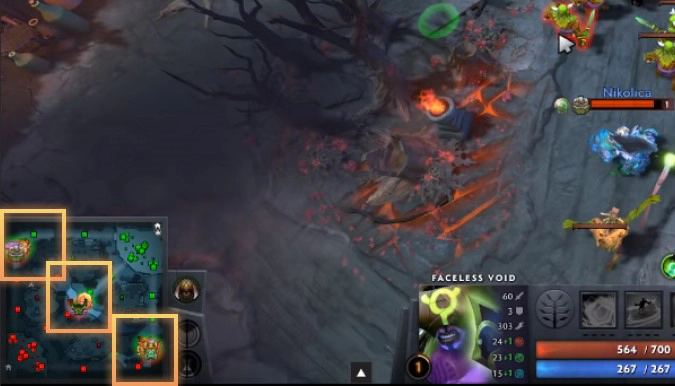
By the way, you can also kill allied creeps, when they have less than 50% health. However, the best way to do it is when the creeps have lesser health and your hero can finish them off with one shot. Allied heroes and towers can also be killed/destroyed when their health drops to 10% and 25% respectively.
The rationale is that destroyed towers and killed heroes don’t give any gold to your enemies. Finishing off allied heroes is possible when they are dying from long-lasting enemy spells or other damage. For instance, when an enemy’s Doom uses silencing and muting spells on your ally, this can dispel the ally and take just 24 damage per second.
Odds are, your ally is doomed to die soon. In this case, killing him would be the best option so that an enemy hero can’t get any gold or experience.
 Finishing off is very important, especially for Midlaner heroes. Once a Laning phase is completed, it is worth going to gank the opponents. You need to realize which abilities your hero has and on which lanes you can commit killings. Together with the allies, it is worthwhile to think it through and bravely attack.
Finishing off is very important, especially for Midlaner heroes. Once a Laning phase is completed, it is worth going to gank the opponents. You need to realize which abilities your hero has and on which lanes you can commit killings. Together with the allies, it is worthwhile to think it through and bravely attack.
Midlaner in the Fighting
The role of the Midlane hero in the teamfight is important both at the beginning and end of the game. While Carry does not have the necessary artifacts, and sometimes experience, the biggest impact in the fight is from the hero who comes from the left line. During the first phase of the game, up to 15–20 minutes, all attention is focused on the Midlaner. Whichever line he comes on creates the backdrop for the initial stage.
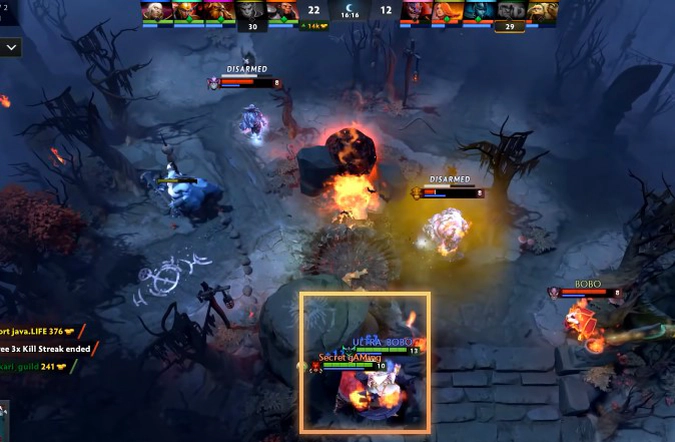
After a Carry hero manages to buy the necessary artifacts, the Midlaner loses some of its position in terms of importance in the fight, but still remains one of the most important players in the team. Therefore, Carries as well as Midlaners must survive in fights as their lives are sometimes much more important to a team than winning a fight.
Midlaner Heroes Examples
Heroes filling the role of Midlaner must have active attack abilities and inflict a large amount of damage over a short time.
- Strength Midlaners: Dragon Knight, Pudge, Huskar
- Agility Midlaners: Templar Assassin, Shadow Fiend, Mirana, Bloodseeker, Viper
- Intelligence Midlaners: Lina, Zeus, Invoker, Queen of Pain, Tinker, Windranger, Death Prophet, Necrophos, Pugna
Third Position – Offlaner
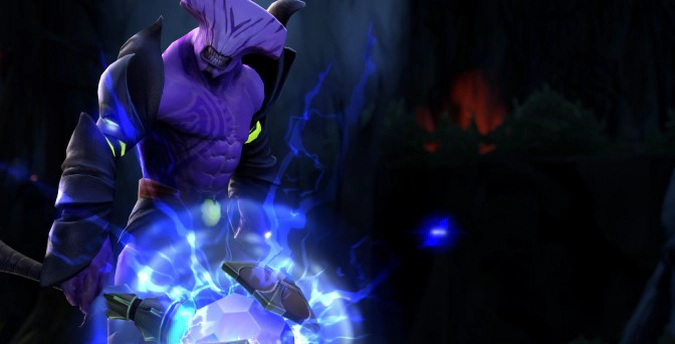
While the first two positions are needed to deal damage and kill at the beginning or end of the game, Offlaner starts the fight or takes control over enemy heroes.
So, what is the role of an Offlane hero? Basically, Offlaners are the initiators with a high health pool or heroes with very strong ultimate abilities.
Offlaner on the Laning Stage
Standing on the off lane (hard lane) is rough luck for heroes. They have to fight against enemy Supports and Carry while trying to farm and survive. In earlier updates, you could access forest (neutral) creeps only on the easy lane, and Offlaners had no creeps except those of the other faction.
Therefore, if there are three heroes — a Carry and two Supports — in front of a hero on the hard line, then the hero simply has to stand and gain experience, or try to draw neutral creeps into the forest and kill them.
The only assistance for the heroes standing in the off lane is the allied support of the fourth position, who sometimes might come and stand with you on the line.
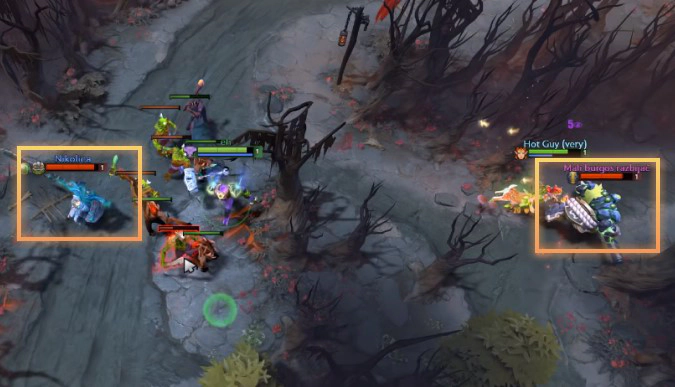
Summing up, during the Laning stage, the Offlaner should not die many times and try not to keep the enemy’s Carry from farming. Also, he must join the ganks initiated by Midlane heroes and try to gather artifacts within the first 15–20 minutes to gain an advantage for further teamfights.
Offlaner in the Fighting
The role of the Offlaner in the fight is sometimes very brief, albeit very important. As we have already said, heroes on this line must have an effective initiation or a strong ultimate ability. One of the important artifacts for heroes in the hard line is the Blink Dagger.
It gives a great positional advantage over the enemies. If you are the initiator, that is, the one who starts the fight, for example Axe, Slardar or Sand King, you have to choose the right position before the fight. This might be in a forest near the line, on a hill behind your enemies, or anywhere else where they do not expect to see you.
At the right time you can enable the Blink Dagger to close in on the enemy’s location and use the ability to initiate and taunt enemy heroes. For example, Axe has the Berserker’s Call, which taunts the enemies and makes them attack Axe for 2 – 3.2 seconds (depending on the level).
While attacking Axe, enemies are disabled and can’t use spells or abilities. This is a great time for Axe’s allies to kill affected enemy heroes.
If an Offlaner hero does not have any strong initiation ability, he can gain momentum by using his ultimate abilities.
For example, Enigma owns the Black Hole, an incredibly powerful ability that can reverse the tide of a fight by killing up to three enemy heroes if used properly. To do so, Enigma takes a good position and waits until the enemies are initiated by his allies and get close together.
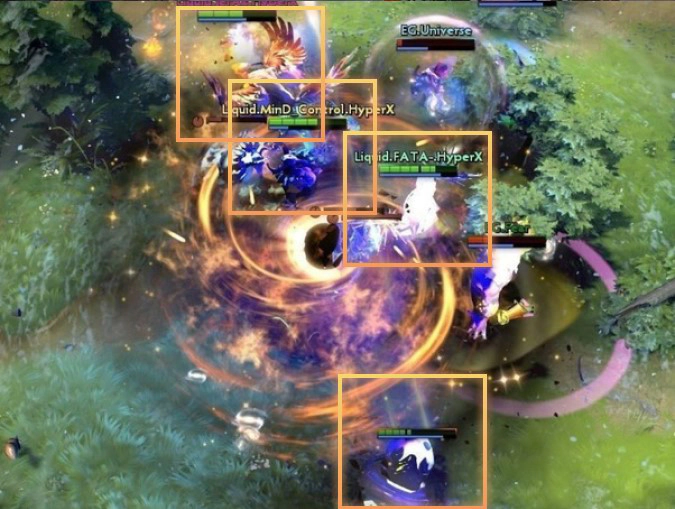
At this time the damage Enigma deals is the most devastating. It takes time to learn this tactic, but a seasoned Offlaner is eventually much more effective than a Carry hero with all his artifacts.
Offlaner Heroes Examples
Heroes on the hard lane must have a large health pool to lane against two or more enemy heroes and survive. Or the hero must have a strong ultimate ability, which can turn the course of the teamfight. There is also a strategy when one more hero, capable of causing the same damage as Carry, is positioned on the hard lane.
- Strength Offlaners: Axe, Slardar, Sand King, Underlord, Tidehunter, Bristleback, Magnus, Abaddon, Clockwerk, Brewmaster
- Agility Offlaners: Faceless Void, Pangolier, Razor
- Intelligence Offlaners: Enigma, Pugna, Necrophos, Dark Seer
Fourth Position – Roamer/Soft Support
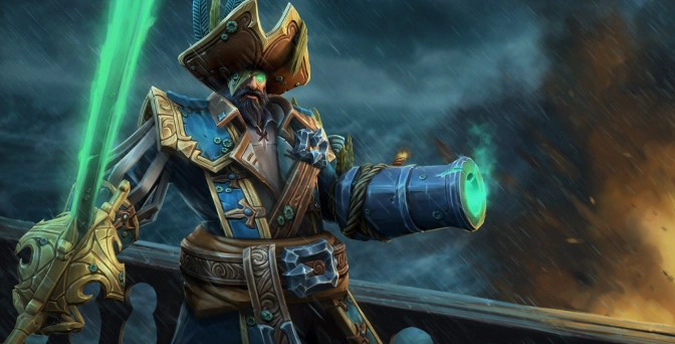
This is one of the two secondary positions in the team. The fourth position player should be good at pressing the keys and feel the game both on lanes and in teamfights like no one else. In a teamfight as well as on the lane, he acts both as an initiator and as a support, as well as an attacking hero.
In a nutshell, he has to be master of all trades, so to say. Such heroes do not deal as much damage as those in first and second positions can. They can’t initiate as the third position heroes do, but besides this, the fourth position is still very important.
Roamer on the Laning Stage
There are several options for how to act while in the fourth position during the Laning stage. The first one is a Roamer — a hero that constantly moves along the lanes and prevents enemy heroes from regular farming by killing them or just dealing some damage and breaking up their health regeneration.
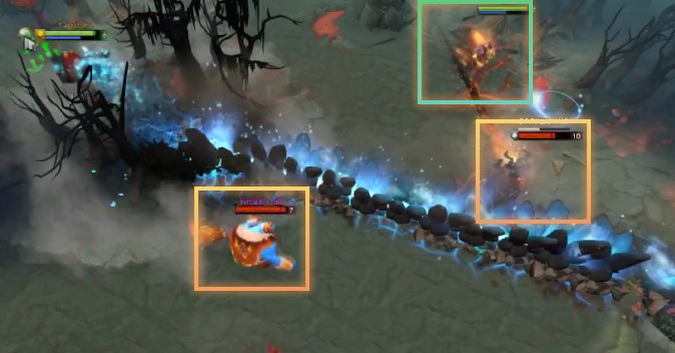
At the same time, Roamers can farm neutral creeps or stack them to help his allied core heroes gain some gold and experience. The main task of the Roamer is timely pulling and attacking the enemies when they least expect it.
The 2+1+2 meta, which has recently become trendy, implies a fourth position hero to be always on the lane together with an Offlaner or Midlaner and help them farm. It is also the case when your Carry needs assistance and both Supports of the fourth and fifth positions are on the same lane.
This is called the triple lane. It works only if there are two enemy heroes standing with the Offlane and your Carry badly needs to farm. It is advisable to get all the necessary artifacts during the Laning stage and, at the same time, try to leave enough farm for your fellow heroes.
Roamer in the Fighting
During the teamfights, fourth position players must do their best to prevent enemies from performing effective attacks, no matter what it takes. The fourth position hero must initiate fights, disable enemy heroes, and sunder enemy positions before attacks or defenses.
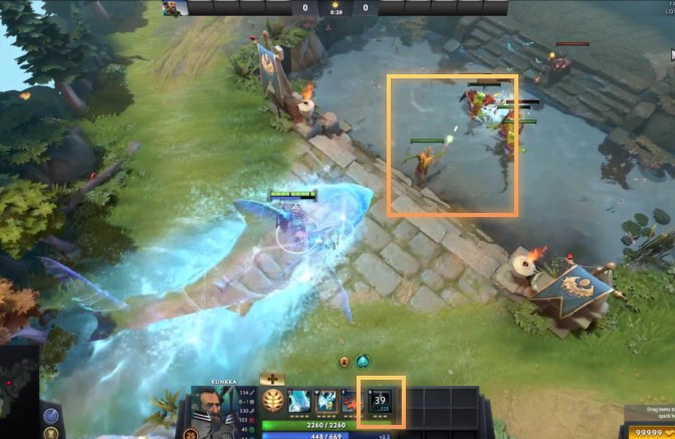 There are several targets to attack in the teamfight for the fourth position players. Depending on the situation on the map, this can be any of the core enemy heroes. The best way is to disable a hero who can currently make the most impact in a fight. This could be a Carry with good artifacts, a high level Midlaner, or an Offlaner with a good ultimate ability.
There are several targets to attack in the teamfight for the fourth position players. Depending on the situation on the map, this can be any of the core enemy heroes. The best way is to disable a hero who can currently make the most impact in a fight. This could be a Carry with good artifacts, a high level Midlaner, or an Offlaner with a good ultimate ability.
In the span of a fight you have to survive and prevent fellow core heroes from getting attacked. When there is a choice to die or to save the life of a core hero, it is better to sacrifice your own life. The death of a Carry means certain defeat for your team.
Roamer Heroes Examples
Many different heroes can be fourth position players. The main criterion here is the abilities defining their play styles. If it’s a Roamer, then you must have the ability to taunt the enemy. If this is a Support hero, you need some appropriate abilities to assist your allies.
- Strength: Kunkka, Clockwerk, Night Stalker, Doom, Spirit Breaker, Io, Earth Spirit, Phoenix, Tusk
- Agility: Bounty Hunter, Vengeful Spirit, Nyx Assassin
- Intelligence: Enchantress, Chen, Dark Willow
Fifth Position – Hard Support
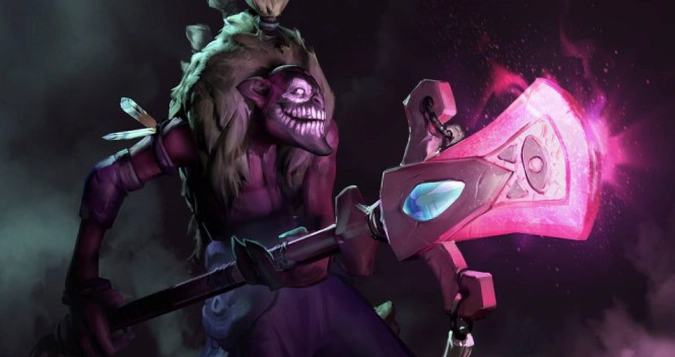
Support is the main assisting hero in the game. The fifth position Support helps the team’s Carry, tries to monitor the whole map, and places Observer and Sentry wards. During teamfights he disables the enemy’s core heroes and heals his allies.
Hard Support at the Laning Stage
Support in the fifth position is usually on the lane with a Carry. The Support is responsible for harassing the enemy Offlaner, alongside trying to prevent him from finishing off the creeps.
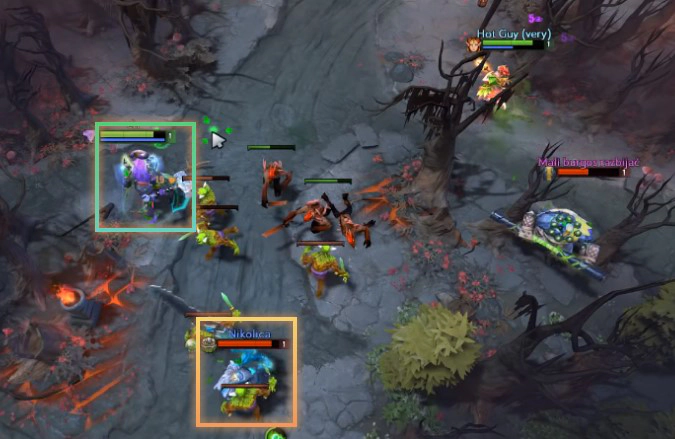
If you do not let the enemy stand still on the line, then eventually the allied creeps become higher in number than the enemy ones and begin to heavily push the line. You should keep an eye on the waves of your creeps to pull them back when it’s necessary so that an enemy Offlaner cannot finish them off while staying safe and sound under his tower’s protection.
This tactic can also help the Support acquire gold from neutral creeps as well as useful artifacts. The rationale behind the creep pulling is to attack neutral creeps, thus making the allied creeps rush back to defend you. Another trick with forest creeps is stacking.
And the next minute, while they are following you, a new stack of creeps will appear in the camp. As a result, you can gather up to 4–5 stacks of creeps within one camp. All these stacks can further help a Carry or Midlaner get a lot of gold. For every creep stack gathered and killed, a Support gets additional gold.
In situations where an enemy attack occurs on your lane, you must do your best to save a Carry — even if this requires sacrificing your own life.
Hard Support in the Fighting
In teamfights, the fifth position player’s actions focus on helping his allies and, if possible, disabling enemy heroes. You must try to survive the very first seconds of a teamfight and not die early on. Later, you need to sustain your allies with healing spells and try to disable the enemy, especially the core heroes. They are the most dangerous to you and your fellows, so must be dealt with as soon as possible.
When there is a chance to save your teammate by sacrificing your own life, do not hesitate. The fifth position Support has the least value and your death gives little gold to your enemies.
Warding
Basically, it is the fifth position Support that is responsible for providing vision to all his allies on the map, therefore reducing vision for the enemies. There are two kinds of wards in Dota 2:
- Observer Ward – Plants an Observer Ward, an invisible watcher that gives your team ground vision to a radius of 1,600. It lasts six minutes and is placed mainly on the hills, in places where the enemy could be located. The ward provides understanding of your enemy’s whereabouts and movements, which can help you and your allies prevail in a fight.
- Sentry Ward – Plants a Sentry Ward, an invisible watcher that grants True Sight — the ability to see invisible units and wards — to any existing allied vision within a radius of 850. You can also use the Sentry Ward to block a stack of neutral creeps.
Hard Support Heroes Examples
Fifth position heroes are mostly Supports. Therefore, the main criterion in choosing the right Support is a range of useful abilities.
- Strength Supports: Io, Phoenix, Treant Protector, Undying
- Agility Supports: Naga Siren
- Intelligence Supports: Crystal Maiden, Shadow Shaman, Keeper of The Light, Disruptor, Ogre Magi, Bane, Lich, Witch Doctor, Warlock, Dazzle, Winter Wyvern
The choice of Dota 2 role and position is quite important and must be done carefully. Before you focus on improving your skills, make sure the role is right for you.
Trade on the go - install the mobile app of DMarket from Google Play or App Store. Never miss great prices and unique skins. The best ota2, Dota 2, Rust and TF2 marketplace is always at hand!


Follow us on Facebook and Twitter to get more useful guides about Dota 2!























